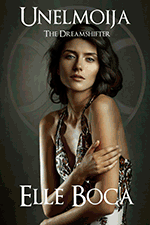Luxury Travel Review

Boutique Burgundy hotel offered elegant accommodations, gourmet meals, area tours
Article and photos by Elena del Valle

Domaine de L’Espérance Marc Meneau
We landed at 8 a.m. at Charles de Gaulle Airport on the outskirts of Paris, France following an overnight flight from the East Coast. From the airport I made my way to the Gare de Lyon train station in southern Paris for a 3 p.m. high speed TGV train to Burgundy. As soon as the train stopped I descended quickly at the small Montbard Station dragging my wheeled luggage down the steps from the platform and out onto the station entrance. After a one hour road transfer through verdant and rain soaked winding roads I arrived at Domaine de L’Espérance Marc Meneau (Grand-rue, Saint Père sous Vézelay, 89450, France, +33 (0) 3 86 33 39 10, fax +33 (0) 3 86 33 26 15, www.marc-meneau-esperance.com, reservation@marc-meneau.com), tired and jet lagged.
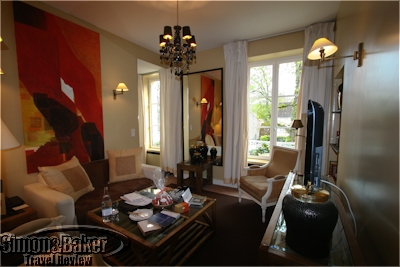
The living area in my junior suite
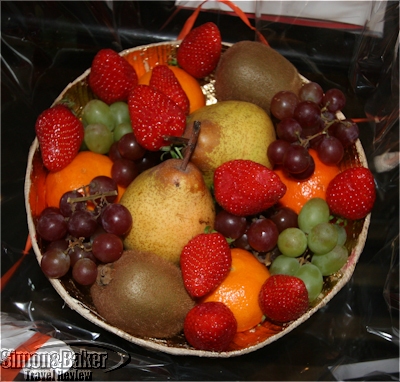
One of the amenities of my junior suite
After settling in in my junior suite one floor above the reception area I pulled on energy reserves to carry me through dinner at the famed L’Espérance de Marc Meneau restaurant, the hotel’s signature dining establishment. It was worth it. To allow my body to adjust to the new time I requested light options from the menu and refrained from imbibing any wine with dinner. The meal was just what I needed and the setting, facing a landscaped garden in the dim light of evening, was beautiful even in the rain and cold of early spring.

The bedroom had an Africa theme
The 32-room four-star hotel was spread into several buildings within easy walking distance from the two-story main building where reception, the bar and restaurants were located. One of my favorite areas of the property were the manicured gardens. Even in early spring they were striking. The gourmet restaurant, the bistro and many of the common area of the main building faced or had a view of the gardens named in memory of Serge Gainsbourg, a friend of the owners who had spent time at their property.
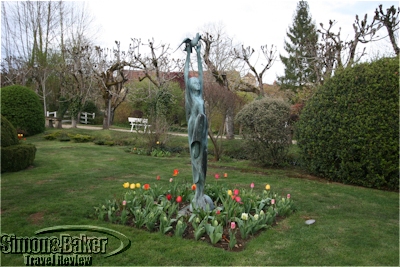
The hotel garden named for Serge Gainsbourg
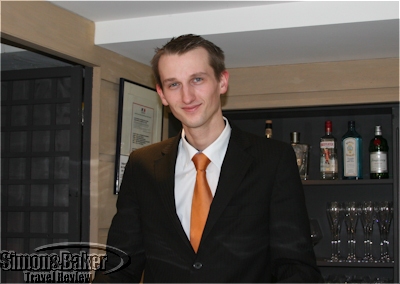
One of the attentive staff members of the hotel
My elegant Africa themed junior suite, one floor up via circular stairs, was well appointed and pretty while at the same time comfortable. Although the view of the main parking lot from my room was less than stellar I was glad to be in the main building with quick and easy indoor access, sheltered from the nonstop rain, to hotel facilities.
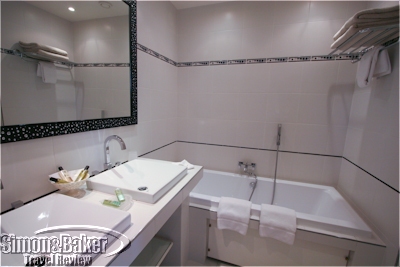
The bathroom in my junior suite
The junior suite, Room 106, had a spotless and spacious bathroom with a bathtub and separate shower. I appreciated the modern conveniences such as complimentary high speed WiFi, television, DVD player and a sound system; and amenities such as thick bathrobe, slippers, Italian toiletries and bitter almond scented Keiji soap, welcome fruit bowl and a box each of house nougat and caramels. Sounds carried. Inside my room I could sometimes hear voices in the hallway and the voices of my next door neighbors, wood creaking, staff cleaning in the morning, and mostly the daytime sounds of drilling and hammering from the construction work on the top floor, right above my suite.
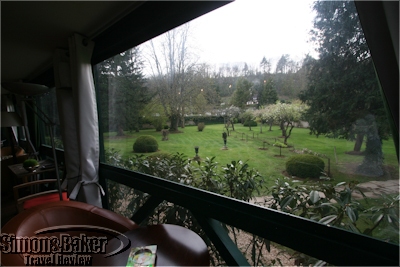
A view of the gardens from Le Bistrot Gainsbourg
There were two types of breakfast, served in a garden facing lounge and in the library from 7:30 a.m. until 11 a.m., Continental (28 euros) and Complet (35 euros). After a few minutes a friendly and attentive server brought me fresh squeezed sweet pulpy orange juice, bowl of fresh fruit (grapes, kiwi, tangerine, strawberries, pear), bowl of mango, small bowl of yogurt, basket of bread and pastries (croissant, pain au chocolate), three types of jam, two small slices of Croque Monsieur (grilled ham and cheese sandwich) and my choice of hot beverage. I ordered chocolate which was served in a large bowl with extra chocolate in a carafe. Although the temperature was hot the chocolate flavor was a bit weak. Breakfast was quite satisfying.
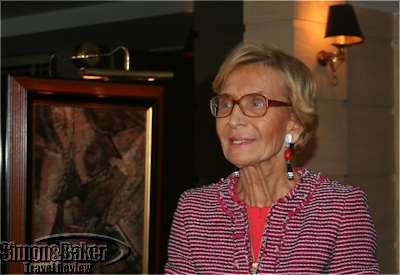
Francoise Meneau
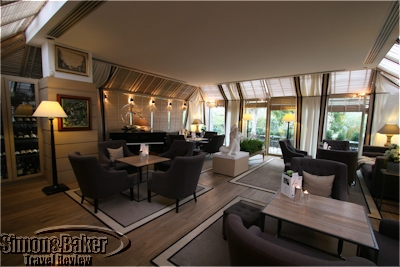
The hotel areas were light filled with ample views of the adjacent gardens
Although I generally prefer exploring independently I sometimes take advantage of tour options. That was the case on this trip. The hotel offered tours of area attractions. During my stay, I had time for an escorted walk, in the rain, around Saint Pere, the tiny village that is home to the hotel and restaurant, and to visit Vezelay, its better known popular neighbor. I would gladly return to the hotel (and restaurant) and dedicate more time to exploring the environs.
Expanding horizons, romantic setting at two Cape Town gourmet restaurants
By Elena del Valle
Photos by Gary Cox
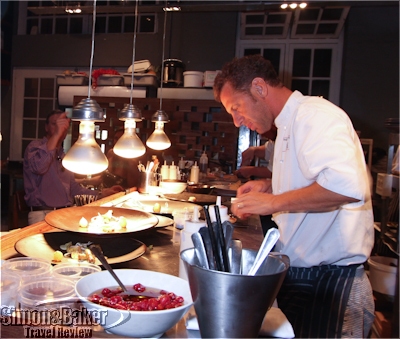
Chef Luke Dale-Roberts preparing plates at The Test Kitchen
On a visit to Cape Town, South Africa earlier this year we had dinner at two gourmet restaurants that although distinct from each other in many ways shared a common passion for fine dinning. One provided an urban chic experience and the other offered classic fine dining in a romantic setting.
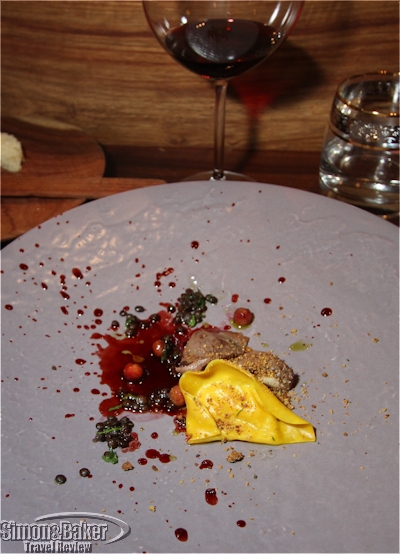
“Shot Pigeon” at The Test Kitchen
For a hip urban dining experience we enjoyed the extended tasting menu at The Test Kitchen. Chef Luke Dale-Roberts was in his element blending common and exotic flavors. There was a long wait list for dinner reservations at the sold out restaurant with modern décor within the Old Biscuit Mill, a renovated mall in an industrial corner of the city. Although there was little activity in the shopping center at night inside the restaurant it was loud and fast paced. It was an entertaining evening. From our Chef’s Table seats we had an opportunity to watch the chef and his staff up close at work in the open kitchen.
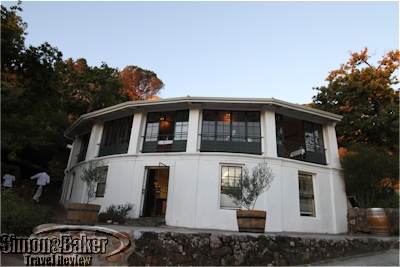
The Roundhouse Restaurant has a water facing view
The Roundhouse, a short drive from the center of the city, was the perfect setting for a romantic dinner. Many restaurants with a view such as theirs dedicate little effort to the meal and service. The opposite was true at the purportedly haunted property. A team of friendly and efficient staff in the dining room complimented the efforts of the kitchen staff, delivering a perfectly prepared and artfully served meal with wine pairings to match the sunset views of Camps Bay. Dinner that night combined gourmet dining and a stunning natural setting in one place.

View of the Twelve Apostles and Camps Bay from The Roundhouse picnic area
Cape Town botanical garden for a flora, birding break
Photos by Gary Cox
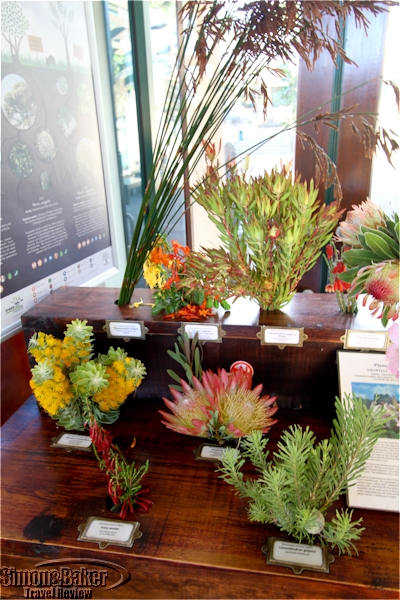
Seasonal plant displays in the entrance hall
When our contributors visited Cape Town earlier this year they spent a morning at the Kirstenbosch National Botanical Garden
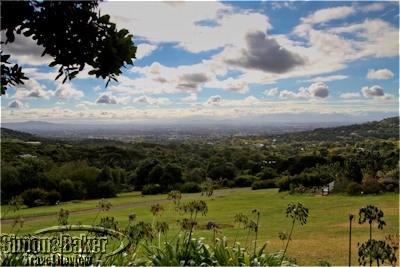
A clear view of the cape flats
Although they were caught by a downpour before they could complete their explorations they had much positive feedback. Click here to read about their visit to the 538-hectare estate with a 36-hectare garden that will celebrate its centenary anniversary next year.
A diamond attraction The Big Hole in Kimberley, South Africa
By Elena del Valle
Photos by Gary Cox
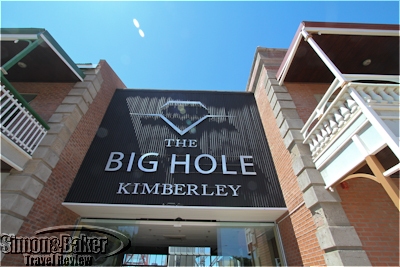
The entrance to The Big Hole exhibit
Miles and miles from the country’s urban centers and famous attractions it seemed, at first glance, that Kimberley, the capital of the Northern Cape, one of the provinces of South Africa, had little to offer tourists. Since the big mine closed even local youth were departing as soon as they could never to return, we heard from a local distressed by the population flight. A closer look revealed that since 1888 Kimberley has been home to De Beers Consolidated Mines (DBCM), South Africa’s largest rough diamond producer, and the Big Hole, a world renowned diamond mine.
Although the mine was no longer active when we visited the area, according to locals and the De Beers websites the company owns the land and helps manage The Big Hole tourist attraction designed to replace some of the revenue lost following the closure of the Kimberley mine. As diamond and history aficionados riding the Rovos Rail train between Pretoria and Cape Town we found a visit to town to see new facilities of The Big Hole appealing. During our three hour stop in Kimberley the train company organized a guided visit for interested passengers to The Big Hole attraction, a museum and display center of the days of glory of Kimberley, offering us an opportunity to see the exterior of the famous Big Hole and learn about its origins and history.
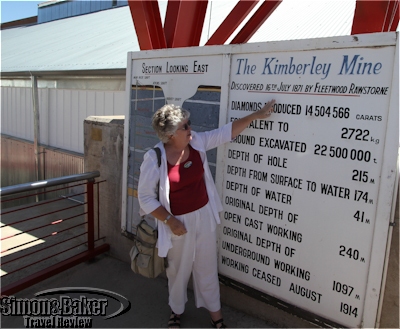
Veronica Bruce told us about the history of the mine
Our excursion began at 9:45 a.m. and ended at 12:30 p.m. on a Saturday in the summer. Veronica Bruce, our knowledgeable and courteous local tour guide, met us at the train station platform. She invited us to pick up a bottle of water from a cooler before boarding a large bus. During the short drive from the station to The Big Hole she described a little of the history of the area and the attraction we were about to visit.
There were several activities on offer at The Big Hole including Underground Mine Experience, Real Diamond Display in a vault (such as the 616, the largest uncut octahedron diamond in the world, and The Eureka), Viewing Platform, Pulsator Building, Diamond & Destiny Film, and Old Mining Town with restored period buildings. The guided tour allowed us to see several of them and maximize our limited time there.
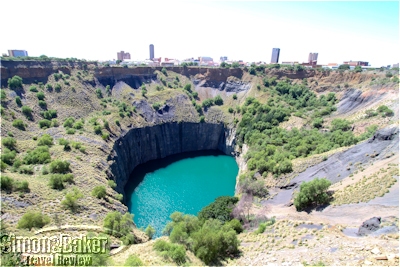
The Big Hole is full of water
To enter we had to pass a hand held metal detector inspection. Once inside the new looking cavernous building with a towering ceiling our tour guide led us to a mini theater where we watched a brief video dramatization reenacting the history of the city with the aid of fictional characters (a travel journalist and a tribesman). We learned that in 1866, Erasmus Jacobs, a 15-year-old playing on the banks of the Orange River, near Hopetown and about 30 miles from present day Kimberley, found the first diamond in the country, a 21.25 carat diamond in the rough his mother gave away thinking it was a worthless rock. It was later named The Eureka.
Following the film we walked onto a cantilevered walkway, 30 Cape feet wide and 30 Cape feet long and the size of a 19 century mining claim, to see the Kimberley Big Hole from above. From our height, well above and to the side of the hole, we saw blue green water filling a very large opening in the African soil; over time rain water had replaced the dirt removed during decades of mining. It was a blistering hot morning, especially atop the unshaded walkway under the punishing rays of the mid morning sun. Although we didn’t want to linger we were mesmerized by the sight of the water filled hole.
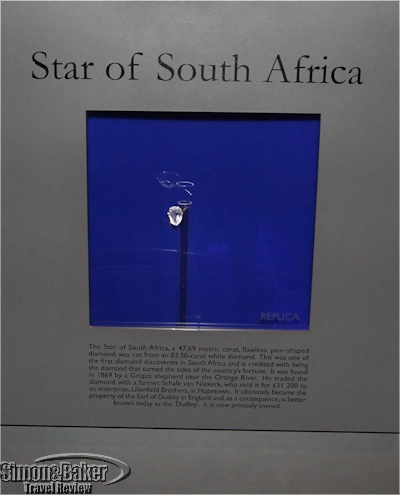
A replica of the Star of South Africa
After listening to her descriptions of the history of the Hole (unofficially diamonds were first found in what would eventually become the Hole by a cook, she explained) we walked down one floor into the old mine now converted into a tourist display with sound effects and lights to showcase for visitors what conditions were like in the old tunnels. There was an elevator with capacity for less than half of our group so most of us took the stairs. Inside the corridor of the former mine she showed us old mining tools and explained the dynamite and mining process used when the mine was first established.
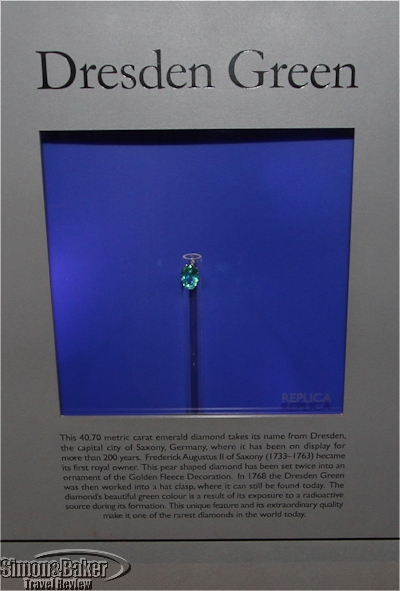
A replica of the Dresden Green
On resurfacing from the underground section we walked to the diamond exhibit in a vault that featured examples of stones and their regions of origin and resin replicas of some of the famed diamonds (a couple of the authentic stones were on loan). Next we saw some of the exhibits that illustrated the diamond mine city’s history. Our guide had allotted 30 minutes of free time for those travelers from our group wishing to visit the attraction curios and diamond and jewelry shops within the complex before the bus departed back to the train station and our onward journey toward the Western Cape.
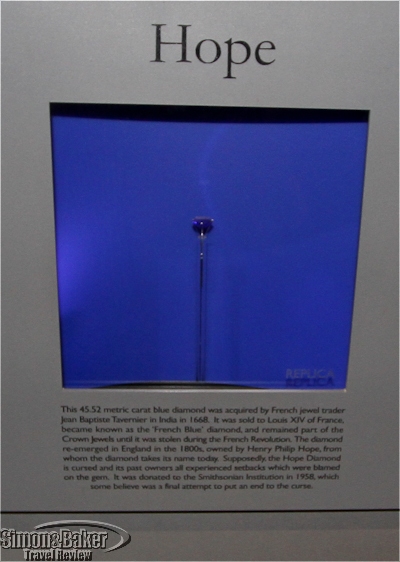
A replica of the Hope Diamond
Serious shoppers would have to rush because there were only two or three small diamond and jewelry and other curio shops and 34 passengers on the train in addition to regular visitors to The Big Hole. The diamond and jewelry shops sold ready made jewelry and loose diamonds. Surprisingly, top quality diamonds were only available in one carat and larger sizes, a sales lady explained in the shop we visited briefly.
Once again there were cold beverages on offer before we boarded the bus for the short drive back to our train. When we arrived at the station Rovos Rail staff awaited us with refresher face cloths and sparkling wine. Soon we were back aboard the train preparing for lunch and reminiscing about the history, the mine and the famous diamonds sourced in Kimberley.
Family suites enhanced luxury Franschhoek property, a favorite
Photos by Gary Cox
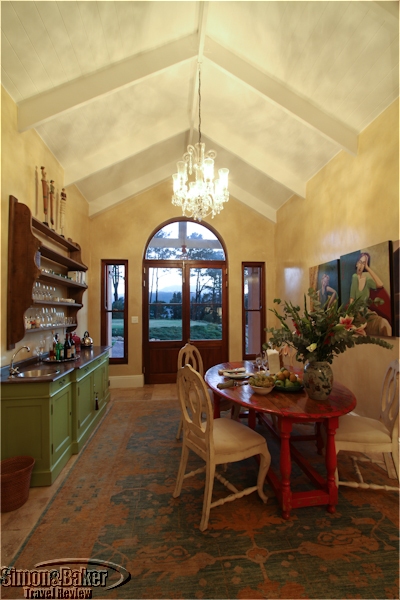
Entry to Villa 1 at La Residence
During a summer trip to South Africa Elena and Gary revisited La Residence Hotel and Villas in the tiny gourmet and wine producing town of Franschhoek about one hour’s drive from Cape Town. They were delighted with the discovery of a new section of the property that welcomed families (the hotel section was reserved for adults and children 12 and older). The Villas added a level of luxury and privacy to the boutique hotel.
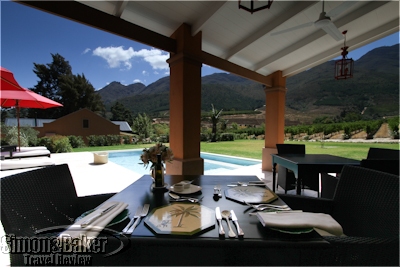
Breakfast looking out on the pool and vineyards
They stayed in a centrally air conditioned stand alone structure, one of several Villas facing the estate vineyards, with two bedrooms, a living and dining area, wet bar, lawn and private swimming pool. The accommodations included superlative service, numerous complimentary amenities including WiFi and local transfers, room service and two dining venues.
An introductory culinary week in Burgundy
Article and photos by Elena del Valle
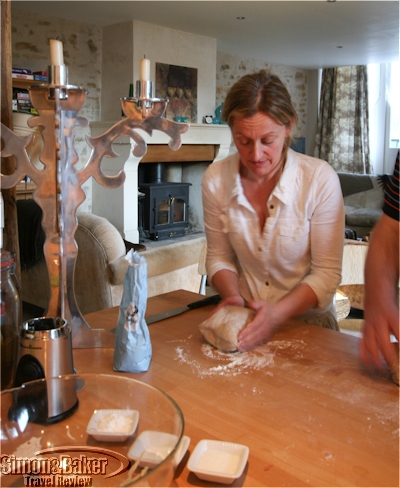
Katherine in class
In late April, I traveled to Burgundy, France for a six-night introductory cooking and culinary small group program with some behind-the-scenes features. Included in the English language program were comfortable and modern accommodations with daily room cleaning, meals, cooking demonstrations, transportation and activities with English speaking guides (a service tip was suggested though not required). As part of the program six of us shared Frelon’s Fabulous France, a five bedroom two-story recently renovated house with a working fireplace, complimentary WiFi connectivity, a private swimming pool and two enclosed courtyards (because of the cold that week the pool remained covered and the courtyards empty of guests).
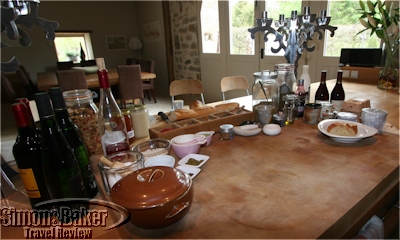
Prime space at the kitchen counter
The house, formerly used as horse stables, had been lovingly renovated by the owners, Katherine and Yannick Frelon, over an intensive 18 month period. The culinary program was led by Katherine, an English cook, and a group of her associates from the same country. It consisted of her cooking demonstrations with some hands on cooking opportunities for those so inclined, daily culinary or wine related excursions, and three non home cooked meals (one a la carte cafe lunch and two set menu gourmet restaurant meals, one lunch and one dinner).
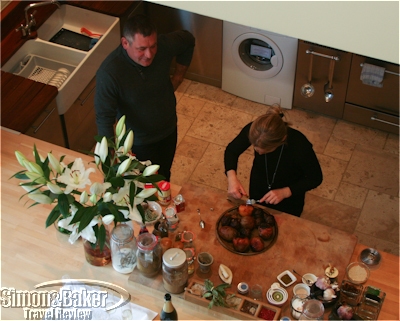
Katherine and Yannick in the kitchen
The house itself, especially the kitchen, was well appointed, spacious and comfortable. Located in Marigny Le Cahouet, a pretty and quiet country village fronting a brook and the famed Burgundy Canal, it provided a placid setting in spite of a rain filled week. The upside of the weather were the uncrowded Dijon market and tourist attractions we visited.
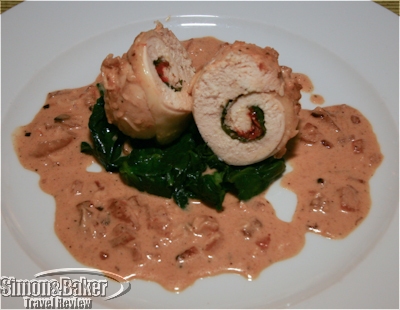
One of Katherine’s many dishes
Katherine, a part-time river barge and freelance cook who had lived in France for many years, dedicated time on four days to cooking demonstrations which resulted in lunch buffets and plated dinners for our group. The meals were prepared from regional fresh ingredients (some from her garden) by her, while we watched and sometimes participated, from her own recipes which she provided in a 72-page printed spiral bound handout on our arrival. Her cooking style, she explained when I asked at the conclusion of the week, is “seasonal, local, fresh and inspired” with recipes designed to translate to cooking students homes on their return to their country of residence.
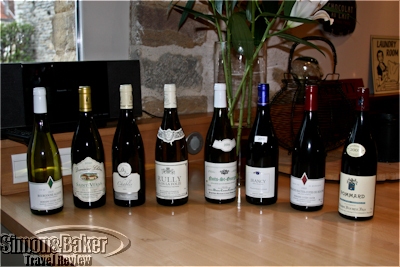
Our first activity was a wine tasting
At the beginning of the week, we were provided with a final itinerary without times or activity duration. Katherine would inform us of times and durations just before the activities on a daily basis or by leaving a printed card atop the kitchen counter. We ate most meals in the house dining room on the ground floor. Breakfast and lunch were self service buffet style and dinner was prepared and plated in the kitchen and served by Katherine or an assistant at the dinner table. Meal times varied depending on the day’s activities. A continental breakfast (hot beverages, self squeezed orange juice, bread, deli meats, cheeses, fresh fruit, yogurt, cold cereal, honey and jams) was usually available an hour or less before departure; lunch was usually served between 1 p.m. and 2:30 p.m. Dinner, usually after 8 p.m., lasted two or more hours.
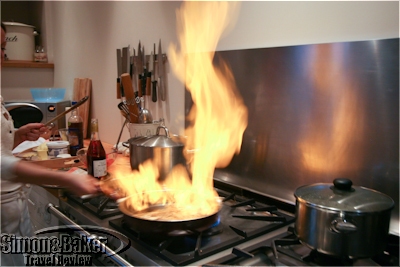
Katherine demonstrated a cooking technique in class
Our days, spent mostly in each other’s company and with Katherine or a guide, were busier than I had anticipated. From breakfast through the end of dinner the majority of our waking hours were taken up by cooking demonstrations, scheduled activities or meals. That week I was reminded that spending time in close quarters with strangers with varied cultural and social backgrounds may be challenging. At times some of the attitudes and behaviors of other guests, particularly those who seemed to monopolize the conversation, complain and make unsolicited and unwelcome critical remarks, were grating and more than once spoiled the moment.
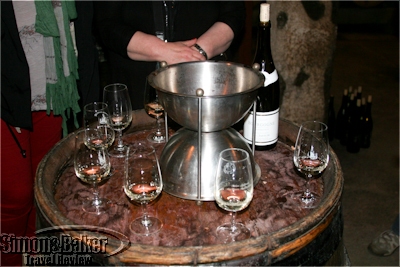
There were several wine tasting opportunities
During the week, there were two wine activities with different guides and visits with tastings to three small family owned wine makers. My favorite experiences by far were the introduction to Burgundy wines by Nancy, a knowledgeable Englishwoman with a ready smile, the first afternoon; and the behind the scenes visit and wine tasting at a Flavigny winery also in her company.
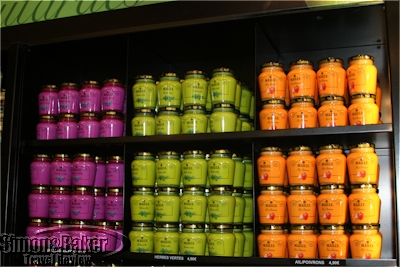
A stop at the Maille mustard shop in Dijon was included
There was a kitchen side cooking demonstration with guest participation at a gourmet restaurant, a visit to Dijon focusing on a market experience and cafe break, a mustard shop stop, a croissant making demonstration by the village baker in the house, and a chocolate shop visit with complimentary hot cocoa and a couple of bite size samples.
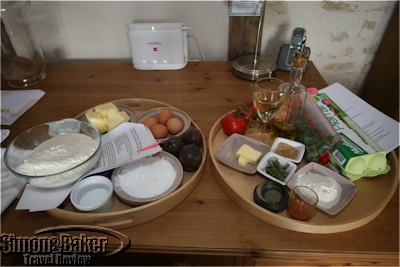
Ingredients for a recipe
On our last full day we went to two wine tastings. We also stopped in Beaune for a light lunch at a central cafe, an optional 30-minute visit with our wine guide to the Hospice de Beaune, a historic building and popular tourist attraction, and an hour at leisure for shopping enthusiasts (most of the shops were closed for 30 minutes of that time).
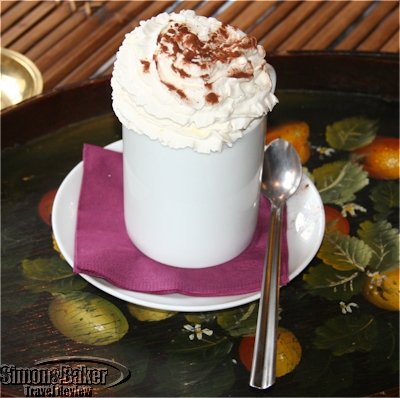
Hot cocoa at the Comptoir des Colonies near the Dijon market
The day after our arrival we drove to a gourmet restaurant in a pretty vineyard setting for a cooking demonstration with the chef followed by a kitchen-side lunch (not a favorite). Unfortunately the chef was in Singapore so the demonstration was conducted in English by one of his staff cooks, a personable Asian woman. Some of the ingredients were unavailable, she informed us at the beginning of the class and had to be substituted in the recipe. Although she tried several times she was unable to demonstrate the foam technique that was central to the recipe; instead of foam the device, when pressed, delivered liquid.
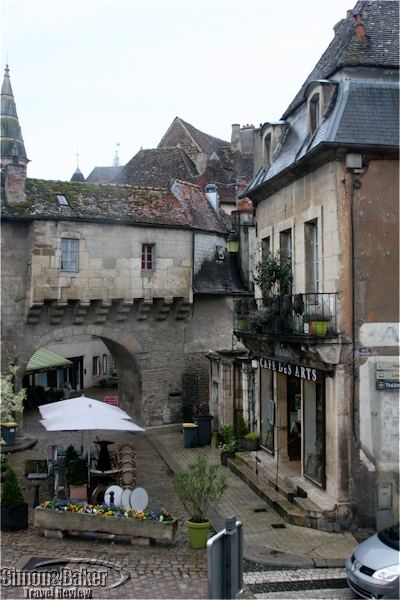
A visit of a cobble stoned street town
Our much anticipated final gourmet meal was at a highly rated restaurant about 30 minutes from the house. On our arrival we were greeted, in charming French accented English, by the owner. Although the restaurant dining room where we were seated faced a lovely garden, our corner table was near the rear of the room rather than the window and my seat faced the wall. A flute of champagne unexpectedly flavored with pear and laurel and a warm cheese pastry amouse bouche distracted me from my initial disappointment of the view. The highlight of the set dinner menu with two house wines was a raw shrimp appetizer and a well cooked river fish. The pigeon was well prepared and presented. I especially liked the tiny but savory thighbone.
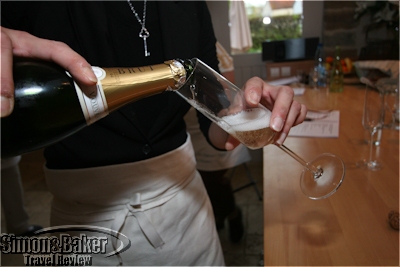
Bubbly was on offer in the afternoons
Following dessert the restaurant manager graciously invited us to the kitchen to meet the chef. While we enjoyed hot beverages in a lounge at the dining room entrance we were presented with a copy each of our menu with photos taken during our brief kitchen visit on the front cover as a memento of the night’s dinner, the closing activity for the week. By midnight we were back at the house and I was busy preparing for my early morning departure to catch the only daily train to the Charles de Gaulle Airport at the nearby Montbard station, a 20-minute drive from the house.
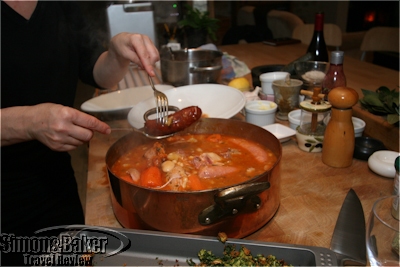
Cassoulet, one of my favorite dishes that week
I would recommend La Ferme de la Lochere (6 Rue de la Lochere, 21150 Marigny Le Cahouet, France, +33 672 86 5609, http://lafermedelalochere.com, katherine.frelon@lafermedelalochere.com) Burgundy culinary program to friends and acquaintances seeking an introduction to culinary Burgundy, related cooking demonstrations and behind-the-scenes activities with an English cook and team, in particular to groups wishing to book the program exclusively or to rent the house.


